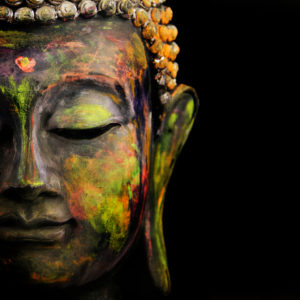Table of Contents - Jump to Section
Meditation and Psychological Transformation
 Before I finally answered my calling to Jungian Analysis and counseling, I practiced and taught psychotherapeutic yoga and bodywork. Meditation was a big part of that. Now, I realize that saying psychotherapeutic in this context might sound pretentious, but it’s the honest truth.
Before I finally answered my calling to Jungian Analysis and counseling, I practiced and taught psychotherapeutic yoga and bodywork. Meditation was a big part of that. Now, I realize that saying psychotherapeutic in this context might sound pretentious, but it’s the honest truth.
I saw the people I that worked with, both students and clients, go through unimaginable psychological transformations through movement and bodywork. They gave up addictions or some other bad habit. People got themselves out of bad relationships. And some finally woke up to a deeper purpose in their lives. That last change is ultimately what I’m getting at when I work with people.
Now to get that place where you can see a deeper meaning in all of your life experiences, you need to go beyond that constantly spinning internal dialogue. Whether you see it in movie-like pictures or hear it as a never-ending commentary on your life, it’s consuming your valuable life force.
People wonder why they have no energy to do the things they love. Well, that’s part of it.
The Internal dialogue
The internal dialogue is something any of us can get trapped in. A lot of that internal dialogue revolves around worrying, beating yourself up, or some other form of self-loathing or -doubt. I see a lot of people in my counseling practice who just can’t stop that interior mental madness. So, I still teach meditation techniques to my clients who want it.
Meditation doesn’t have to be anything formal. You don’t have sit on a cushion or gaze at your navel. Meditation is just a way to slow things down so that you can take a witnessing perspective on what’s happening in your mind rather than just falling into it and letting it spin out of control. It starts with separating your self from those negative thoughts and emotions that arise within your awareness. If that sounds strange, it’s okay. That’s why I’m sharing this with you.
Dream interpretation can really help you make that split between you and your thoughts and emotions. For example, you may be someone who suffers from self-doubt and negativity. The kind that keeps you up at night. Let’s say you dream of a hateful woman who’s really bringing you down. This is psyche’s way of showing you what part of yourself that negative talk comes from. Next, you have to figure out just what she is in you. Where did she come from? What does she want?
In the article on Jungian perspectives of depression and anxiety, I talked about cultivating the art of having a conversation with yourself. This is what we work on in Jungian analysis and dream interpretation. But before that, you have to have the means to separate yourself from those internal figures.
What is meditation?
Yoga is the intentional stopping of the spontaneous activity of the mindstuff.
Yoga is the stilling of the patterning of consciousness.

It would be difficult to discuss the question, “What is Yoga” or even talk about Yoga without looking at the Yoga Sutra. The Yoga Sutra is an invaluable tool for Westerners because it offers a perspective on the inner workings of the mind. It is a good starting point for learning about meditation – something which is essential for stopping the internal dialogue.
I wanted to begin a discussion of the Yoga Sutra with two translations, both of them from Western translators (respectively): Joseph Campbell and Chip Hartranft.
Meditation: Movement and Stillness
Before we can access its full potential, we must first understand how the mind works. Implicit in this one Sutra are two fundamental states of the human mind – stillness and movement. We can say that movement, or the patterning of consciousness, is the means by which we express our emotions, feelings, thoughts, and behaviors. This is the quality of mind that changes. It also represents the mind’s capacity to give shape to our unique personalities.
Its drawbacks are that we can too easily become identified with our mind’s myriad manifestations. Think about how much we identify with our own perceptions. Say for example, the ideas we have about another person or another way of life that is totally different from ours.
Search your mind for someone whose way of life is absolutely different from yours (deranged criminal behavior aside). See if you can feel the grip that perception has on you when you try and consider that person or that way of life as having validity.
Mediation and breaking patterns of habit
 In Chip Hartranft’s translation, he refers to movement as the habitual patterning of consciousness. In and of itself, the habitual patterning of the mind is not a bad thing. It’s related to neuroplasticity. It is how we develop skill in any activity, mental or physical. However, this same patterning is also what establishes our unconscious habits. We have physical, mental, and emotional patterns of habit. Any of those can be changed, as I talked about in my article on how meditation can change the world. And by that I only mean that meditation can change your perspective of the world.
In Chip Hartranft’s translation, he refers to movement as the habitual patterning of consciousness. In and of itself, the habitual patterning of the mind is not a bad thing. It’s related to neuroplasticity. It is how we develop skill in any activity, mental or physical. However, this same patterning is also what establishes our unconscious habits. We have physical, mental, and emotional patterns of habit. Any of those can be changed, as I talked about in my article on how meditation can change the world. And by that I only mean that meditation can change your perspective of the world.
If you change your perspective then you change your perception. If you can master that, the world becomes a whole new place – even in our darkest moments.
In counseling, Jungian analysis, or dream interpretation one of my aims is to help you free yourself from unconscious habits. A pattern of habit is an unconsciously engaged, rigidly entrenched, automatic behavior which hinders us from acting authentically in the moment. The effects of habitual patterns can be seen not only in our emotional responses, behaviors, and belief systems, but also in our postures and movements.
The stillness of meditation
 Stillness is the innermost state of being which when accessed, gives us a resting place from all of the mind’s activity. I think it is safe to say that many people flit from one thought to the next, never realizing that within them is a deep, silent, place of peace and stillness. Think about this place of stillness as the space between thoughts. If you can learn to slow down your thoughts, you can access that space. Whether you tend to talk to yourself in internal dialogue or visualize yourself in one: try slowing things down and hear or see them in slow motion. Use the breathing technique discussed here to help you slow down.
Stillness is the innermost state of being which when accessed, gives us a resting place from all of the mind’s activity. I think it is safe to say that many people flit from one thought to the next, never realizing that within them is a deep, silent, place of peace and stillness. Think about this place of stillness as the space between thoughts. If you can learn to slow down your thoughts, you can access that space. Whether you tend to talk to yourself in internal dialogue or visualize yourself in one: try slowing things down and hear or see them in slow motion. Use the breathing technique discussed here to help you slow down.
We will explore the deeper aspects of stillness in the next post on the Yoga Sutra. For now, try to notice the various ways your mind wanders. Are you able to still that movement and focus on one single thought? Try visualizing and focusing on just the number 3. Repeat it to yourself if you have to in order to hold that thought. How long is it before your mind wanders? Please share your experiences.
